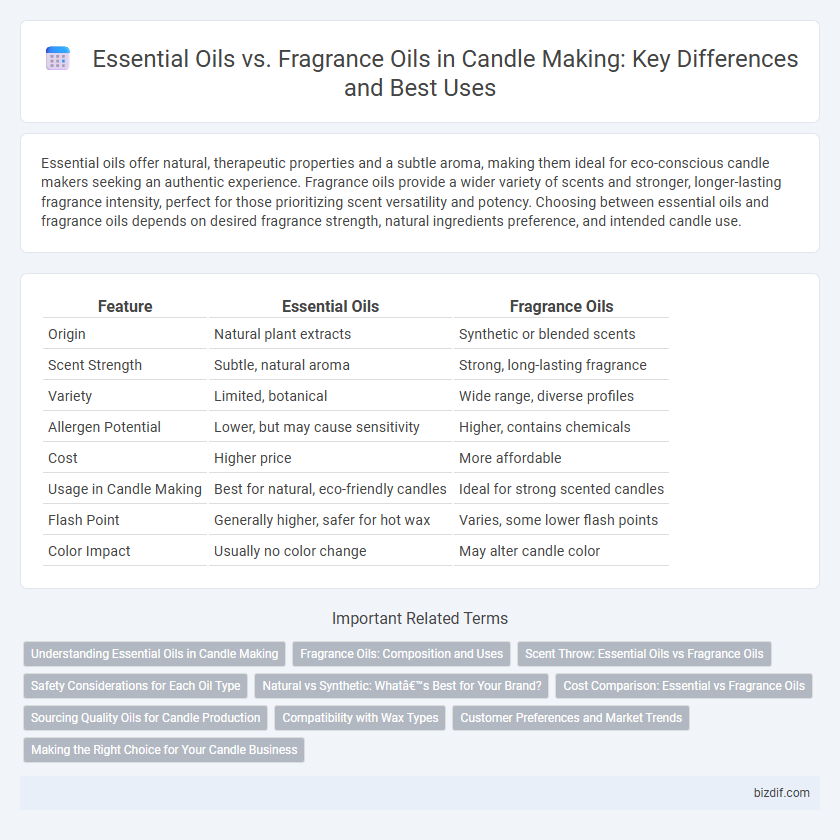Essential oils offer natural, therapeutic properties and a subtle aroma, making them ideal for eco-conscious candle makers seeking an authentic experience. Fragrance oils provide a wider variety of scents and stronger, longer-lasting fragrance intensity, perfect for those prioritizing scent versatility and potency. Choosing between essential oils and fragrance oils depends on desired fragrance strength, natural ingredients preference, and intended candle use.
Table of Comparison
| Feature | Essential Oils | Fragrance Oils |
|---|---|---|
| Origin | Natural plant extracts | Synthetic or blended scents |
| Scent Strength | Subtle, natural aroma | Strong, long-lasting fragrance |
| Variety | Limited, botanical | Wide range, diverse profiles |
| Allergen Potential | Lower, but may cause sensitivity | Higher, contains chemicals |
| Cost | Higher price | More affordable |
| Usage in Candle Making | Best for natural, eco-friendly candles | Ideal for strong scented candles |
| Flash Point | Generally higher, safer for hot wax | Varies, some lower flash points |
| Color Impact | Usually no color change | May alter candle color |
Understanding Essential Oils in Candle Making
Essential oils are natural aromatic compounds extracted from plants through processes like steam distillation and cold pressing, offering authentic scents with therapeutic benefits in candle making. Their volatile nature requires careful handling and lower fragrance load to maintain scent integrity and ensure candle safety. Understanding the chemical properties and compatibility of essential oils with wax types optimizes scent throw and enhances the overall candle experience.
Fragrance Oils: Composition and Uses
Fragrance oils are synthetic blends created from aroma compounds, essential oils, and solvents, designed to provide consistent and long-lasting scents in candle making. Their composition allows for a vast range of scents, including those difficult to achieve with natural essential oils, such as gourmand, floral, and exotic fragrances. Widely used in candles due to their strong throw and stability during burning, fragrance oils enhance the sensory experience without the variability inherent in natural oils.
Scent Throw: Essential Oils vs Fragrance Oils
Essential oils offer a natural aroma but tend to have a lighter scent throw compared to fragrance oils, which are specifically formulated to release stronger and longer-lasting scents in candles. Fragrance oils contain synthetic components designed to enhance the scent throw both when the candle is unlit (cold throw) and burning (hot throw). Choosing the right oil affects the overall fragrance performance and ambiance, with fragrance oils often preferred for more intense and consistent scent distribution.
Safety Considerations for Each Oil Type
Essential oils, derived from natural plant extracts, require careful dilution and testing for skin sensitivity and potential allergic reactions when used in candle making. Fragrance oils, often synthetic, may contain chemicals that emit harmful fumes if overheated, necessitating adherence to recommended usage rates and proper ventilation. Both oil types must be evaluated for flash point and compatibility with wax to ensure safe burning and avoid health hazards.
Natural vs Synthetic: What’s Best for Your Brand?
Essential oils are derived from natural plant extracts, offering authentic aromas and therapeutic benefits, which appeal to eco-conscious candle brands prioritizing sustainability and wellness. Fragrance oils, often synthetic or blended with natural compounds, provide a wider variety of consistent and long-lasting scents, making them ideal for brands seeking cost-effective versatility and strong fragrance throw. Choosing between essential and fragrance oils depends on brand values, target market preferences, and ingredient transparency, balancing natural purity with scent diversity.
Cost Comparison: Essential vs Fragrance Oils
Essential oils typically cost more per ounce due to their natural extraction process and purity, averaging between $15 to $50, while fragrance oils are generally more affordable, ranging from $5 to $20 per ounce. The higher price of essential oils reflects their therapeutic benefits and organic sourcing, whereas fragrance oils offer a wider variety of scents at a lower price point. Cost-effectiveness depends on the candle maker's priorities for natural ingredients versus budget-friendly scent options.
Sourcing Quality Oils for Candle Production
Choosing high-quality essential oils for candle making ensures natural aromas derived from plant extracts, contributing to safer, eco-friendly candles. Fragrance oils, often synthetic, provide a broader variety of scents and greater consistency but require scrutiny of ingredient sources to avoid harmful chemicals. Reliable suppliers prioritize transparency, purity, and batch testing, which directly impact the scent throw, burn quality, and overall candle safety.
Compatibility with Wax Types
Essential oils are natural extracts that blend best with soy and beeswax due to their delicate molecular structure, which preserves scent integrity during the curing process. Fragrance oils, synthetically formulated, demonstrate broader compatibility across various wax types including paraffin and palm wax, offering stronger scent throw and stability. Selecting the appropriate oil ensures optimal scent diffusion and longevity aligned with specific wax characteristics.
Customer Preferences and Market Trends
Customer preferences in candle making increasingly favor essential oils due to their natural origin, therapeutic benefits, and authentic aromas, aligning with growing demand for wellness and eco-friendly products. Fragrance oils remain popular for their wide scent variety, stronger throw, and affordability, appealing to budget-conscious consumers seeking diverse fragrance options. Market trends show a rising hybrid approach, blending essential and fragrance oils to balance natural appeal with scent performance, meeting diverse consumer expectations in the candle industry.
Making the Right Choice for Your Candle Business
Essential oils provide natural, therapeutic aromas extracted directly from plants, offering eco-friendly and authentic scents for handmade candles, while fragrance oils deliver a broader variety of potent, long-lasting fragrances often created synthetically to enhance scent throw and consistency. Candle makers must evaluate factors like cost-effectiveness, scent strength, customer preferences, and target market to decide between essential oils and fragrance oils for their products. Choosing the right type of oil ensures optimal performance, safety, and brand alignment, ultimately influencing the success and appeal of a candle business.
Essential oils vs Fragrance oils Infographic

 bizdif.com
bizdif.com